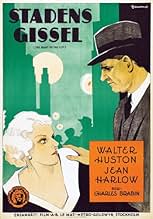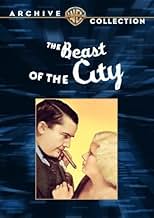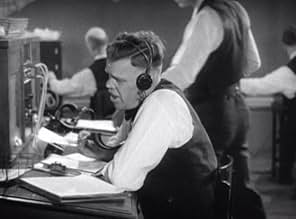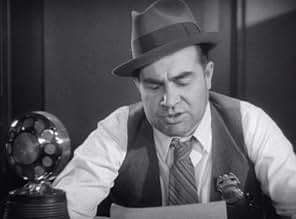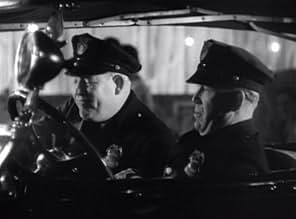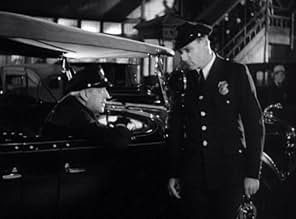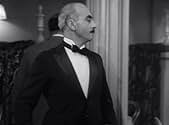Aggiungi una trama nella tua linguaPolice Chief Jim Fitzpatrick ruthlessly goes after organized crime and is prepared to use brutal and violent methods to fight it.Police Chief Jim Fitzpatrick ruthlessly goes after organized crime and is prepared to use brutal and violent methods to fight it.Police Chief Jim Fitzpatrick ruthlessly goes after organized crime and is prepared to use brutal and violent methods to fight it.
- Regia
- Sceneggiatura
- Star
- Detective
- (non citato nei titoli originali)
- Mayor
- (non citato nei titoli originali)
- Turnkey
- (non citato nei titoli originali)
- Police Dispatcher
- (non citato nei titoli originali)
- Policeman #5 on Telephone
- (non citato nei titoli originali)
- Pat - Car 47 Driver
- (non citato nei titoli originali)
- Joel - Policeman Outside Car 47
- (non citato nei titoli originali)
Recensioni in evidenza
Well-directed and well-written with solid acting, especially for 1932. Harlow is her usual alluring self. Huston is great in a part that is not very sympathetic, despite his being the protagonist. Early work by J. Carrol Naish as Hersholt's henchman, Cholo. Speaking of Hersholt, he was the only suspect casting. I'm not bashing Hersholt because he was a fine actor. But hearing him spout gangster slang through his thick accent was a little silly. Mickey Rooney has a small part as one of Huston's kids.
Another great Walter Huston movie from the '30s. He made a lot of interesting ones. The aim of this particular film is to glorify cops not criminals. At least that's what the Herbert Hoover-signed message before the credits says. Yet the ultimate message of the movie is that in order for the cops to stop the criminals, they have to abandon the rule of law and take matters into their own hands. The final shoot-out between the gangsters and the vigilante cops is amazing.
*** (out of 4)
MGM gangster film shown from the point of view of the police. Capt. Fitzpatrick (Walter Huston) is out to bring down gangster Sam Belmonte (Jean Hersholt) but is sold out by his brother (Wallace Ford) who has fallen for the gangster's girl (Jean Harlow). This film is certainly a lot different than the Warner gangster pictures as it doesn't glamorize the gangsters but instead puts the spotlight on the public for allowing gangs to rule the streets. Huston is his usual fiery self and both Ford and Harlow shine in their supporting roles. The subplot between Ford and Harlow is a bit weak but it leads to a highly powerful ending, which is among one of the best scenes from all the gangster films from this period.
As with any piece of popular entertainment that is nearly 70 years old, there are going to be dated elements. What is more important is how relatively modern this film feels, especially compared to the films made under the Production Code after 1934. The story is a hard slice of life, and it will not suit all tastes. This is especially true for those who have been too conditioned by Production Code features and television.
The ending has been compared to Sam Peckinpah's THE WILD BUNCH and Don Siegel's DIRTY HARRY, and not without cause. However, try to imagine yourself as a member of the original theatrical release audience in 1932. There would have been very little to prepare you for it, apart from DOORWAY TO HELL, LITTLE CAESAR, PUBLIC ENEMY, and SCARFACE. The difference here is that the story is told from the point of view of the men in law enforcement. It focuses on something that was common knowledge at the time, that prohibition had corrupted law enforcement far beyond the scope of anything the public had ever known.
The remedy for corruption that this film prescribes is very strong medicine indeed. You may not like it, but I defy you not to think about it for a long time after you've seen it.
Lo sapevi?
- QuizMickey Rooney had just turned 11 years old when he played Walter Huston's young son in his first full-length sound feature film. His character's name is also "Mickey," and his first line is, "Say, those don't look like pancakes!"
- BlooperWhen Ed and Daisy first kiss, in a medium shot, he's holding her head in the crook of his left arm, and her right had is on his side. In the next closer shot, his arm is down and her right hand is up on his lapel.
- Citazioni
Daisy Stevens, aka Mildred Beaumont: [Ed grabs her arm tightly] Say! That hurts a little bit.
Det. Ed Fitzpatrick: And you don't like to be hurt, do you?
Daisy Stevens, aka Mildred Beaumont: Oh, I don't know.
[Suggestively]
Daisy Stevens, aka Mildred Beaumont: Kinda fun sometimes if it's done in the right spirit.
Det. Ed Fitzpatrick: [Pushes her away] Get the beer!
- Curiosità sui creditiOpening card: Instead of the glorification of cowardly gangsters, we need the glorification of policemen who do their duty and give their lives in public protection. If the police had the vigilant universal backing of the public opinion in their communities, if they had the implacable support of the prosecuting authorities and the courts, I am convinced that our police would stamp out the excessive crime, which had disgraced some of our great cities. ---- President Herbert Hoover
- ConnessioniFeatured in Harlow: The Blonde Bombshell (1993)
- Colonne sonoreChopsticks
(1877) (uncredited)
Traditional piano tune
Music by Euphemia Allen
Played on piano by Betty Mae Crane and Beverly Crane
I più visti
- How long is The Beast of the City?Powered by Alexa
Dettagli
- Data di uscita
- Paese di origine
- Lingua
- Celebre anche come
- The Beast of the City
- Luoghi delle riprese
- 3849 Main Street, Culver City, California, Stati Uniti(robbery at the Bank of America branch)
- Aziende produttrici
- Vedi altri crediti dell’azienda su IMDbPro
Botteghino
- Budget
- 230.000 USD (previsto)
- Tempo di esecuzione
- 1h 26min(86 min)
- Colore
- Proporzioni
- 1.37 : 1


